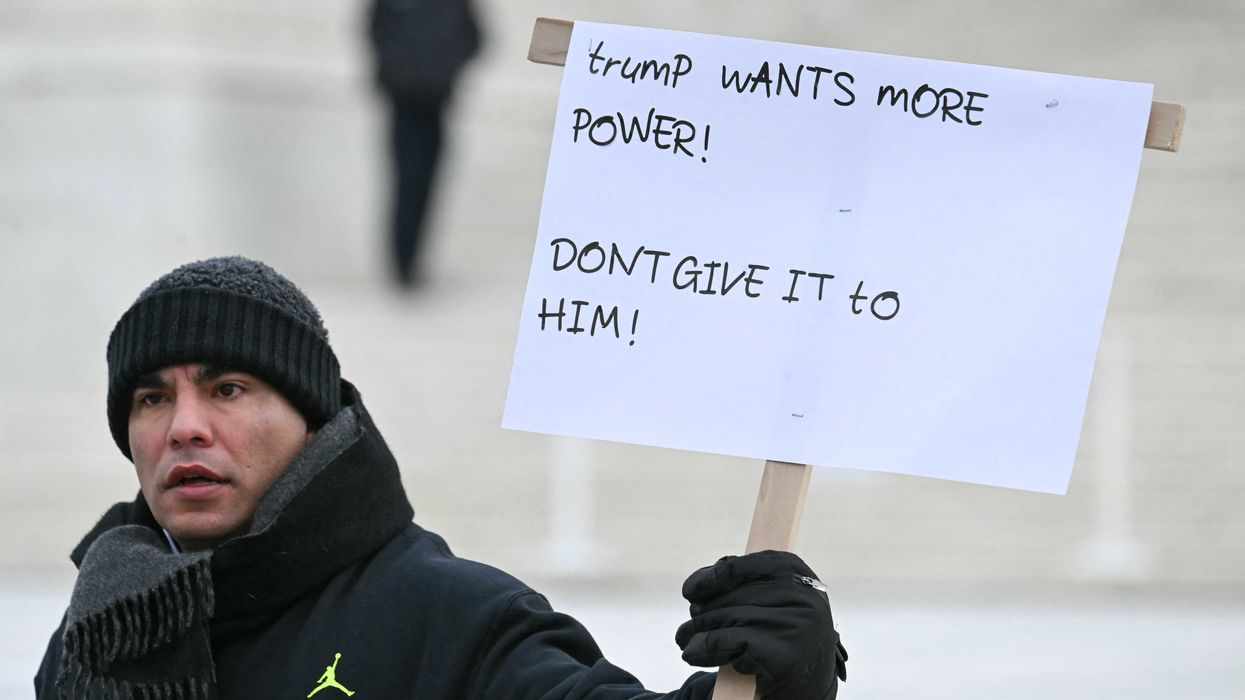On this day 247 years ago, the Second Continental Congress passed the Flag Resolution of 1777 making the "Stars and Stripes" the official flag of the United States of America.
Symbols are a vital part of the identity of a nation. They speak of the values and origins of the country, where they are going, and where they have been. They serve as a benchmark by which to measure the condition of the present society—are we closer to being the people our forefathers imagined all those years ago? They tell a story of the struggles and hardships of the men who first bore those symbols and what they stood to protect.
This Flag Day, we are taking the opportunity to reflect upon the rich history and symbolism of American Flags and the conflicts that shaped them. From the earliest colonial rebellions to modern military operations, here are five flags that symbolize America:
Pine Tree Flag

Encyclopaedia Britannica / Contributor | Getty Images
Despite the media's claims, this flag is not a Christian Nationalist banner, nor a banner of any other extremist group. The origin of this flag well predates any of those modern groups as it was first created during the Revolutionary War.
The flag comprises two items: the pine tree and the text, "An Appeal to Heaven." The pine tree has long been a symbol of New England, even before Europeans landed in North America. The pine tree was an important symbol of peace to the Native tribes of New England after a great war between five tribes ended with the members settling their differences and burying each other's weapons under a pine tree. After the Europeans arrived, the pine tree remained significant. A large part of colonial New England's economy was based on shipbuilding using the tall pine trees local to the area.
The other portion of the flag, the text that reads "An Appeal to Heaven," is a quote from the English philosopher John Locke's famous book, The Second Treatise of Civil Government. In this particular passage the quote is referring to, Locke outlined the right of people to revolt against a tyrannical government. Locke argued that once you have exhausted your ability to appeal your grievances through the available government channels, you can make an appeal to heaven and throw off the shackles of tyranny through a revolution. As you can imagine, this particular passage was critical to the philosophical justification for the American Revolution.
Francis Hopkinson Flag

Encyclopaedia Britannica / Contributor | Getty Images
Everyone knows the tale of Betsy Ross, a Philadelphia seamstress who was presented—by none other than George Washington himself—with a sketch of the flag that would come to represent the fledgling nation. After convincing Washington to reduce the points on the stars from six to five, Ross got to work sewing the first stars and stripes together. Before long, she was presenting George Washington with the first American flag with its iconic ring of stars.
Unfortunately, that story is more legend than fact. Betsy Ross did exist. She was a seamstress from Philadelphia, and she most likely did make some of the first American flags. But did she collaborate with George Washington to create the very first American flag? Not likely. Modern historians now tend to credit a man named Francis Hopkinson.
Francis Hopkinson, like many of our founding fathers, was a very interesting man. Along with serving as one of New Jersey's first congressmen, Hopkinson signed the Declaration of Independence and was a lawyer, poet, musician, and artist. It was his skill as an artist that led to him to design the flag. However, the journals of the Continental Congress suggest that he was not the only person consulted during the process. While it is unclear who these other people were (perhaps it was Besty Ross), it is known that Hopkinson would be credited with the creation of other important symbols and devices, including the Great Seal of the United States of America.
Fort Sumter Flag

In April of 1861, the nation split itself in two. The attack on Fort Sumpter in South Carolina marked the beginning of the Civil War, and for many people, it must have felt like the end of the republic. This flag, bearing 33 stars for the 33 states, flew above Fort Sumpter during the assault and was lowered when the fort was surrendered to Confederate forces. After the battle, President Lincoln had a decision that no president before or since has been faced with: would he keep the flag as it was or would he remove the stars that represented the states that had seceded?
Lincoln's mission was to preserve the union—to reform what had been broken—so he decided to keep the stars on the flag. This flag, with all 33 of its stars, came to represent what the Union troops were fighting for. They were defending the Union for which the flag had become the sacred symbol. As such, the flag was imbued with the religious and moral values that were violently clashing along the Mason-Dixon line. For many, the flag represented the abolition of slavery, and for many newly freed black Americans, the flag represented a brighter future and an opportunity to participate in the American Dream.
When the Stars and Stripes were once again flown over Fort Sumpter in February of 1865, just two months before the end of the Civil War, all 33 stars were present—plus two more to represent the new states that had joined the union during the war. While it would take decades for the wounds of the Civil War to heal, President Lincoln was successful in his mission to reunite America.
D-Day Flag

D-Day was the largest amphibious invasion in military history with over 156,000 Allied troops deployed to liberate Europe from the Nazi regime. America bore a significant portion of the burden, with sending 75,000 of the total 156,000 Allied troops. Moreover, most landing craft and support vehicles were manufactured in the United States. It was aboard one such landing craft, the L.S.T. 493, that the flag above was carried into the chaos. The L.S.T. 493 was one of the largest vessels to make an appearance in Normandy, and it was tasked with running supplies to the different beachheads along the coastline, which it did from June 6th, 1944 (D-Day) until the Battle of Normady's completion at the end of August 1944.
Despite being manufactured by the U.S. and carrying an American flag, L.S.T. 493 was operated by the British during the Battle of Normandy, which was not an unusual arrangement at the time. The vessel served until April 1945 when it was sent from Portland, UK, to Plymouth, UK, for routine maintenance. During this trek, the ship's navigation lights were turned off as per wartime procedures, and consequently, it was badly damaged by large concrete pyramids installed in the breakwater. These pyramids were called "dragonteeth" and were used as a defense against invasion. The ship was abandoned, and the crew was safely evacuated, but L.S.T. 493 was deemed too damaged to repair and was left behind.
The aforementioned 48-star American Flag was removed well before L.S.T. 493 wrecked and made its journey throughout the years before finding itself in Glenn's collection in the American Journey Experience museum. Glenn had the following to say regarding his acquisition of the flag:
“When I first saw this flag I was overwhelmed with the struggle and the power of the human spirit. While the human experience is itself exceptional, those who deny the will to endure and the willingness free mankind from those who wish to control and oppress miss what makes the average American truly exceptional throughout the world"
America's Flag of Valor

This last flag is a reminder that the fight for freedom is never over. There will always come a time when brave men will be called upon to lay down their lives in the pursuit and preservation of liberty, to fight on behalf of those who can't fight for themselves.
Imagine—it's March 2003, America is still recovering from the horror of the 9/11 terrorist attacks, and a group of young men full of courage and determination board a plane in Germany bound for Kuwait City to engage in the initial attack of the Iraqi Freedom Campaign. These Marines, most of whom were fresh out of BootCamp and had never faced battle before, were asked to sign this flag by Flight Attendant Sarah Carruthers.
Susan Irvin, the custodian of this incredible artifact, is working on tracking down the fate of these brave soldiers. One can assume that many of the signees didn't make it back to the United States. The same spirit and determination that motivated our forefathers to fight for liberty were in these men as well, and that spirit still isn't lost amongst us today.
Here are just a few of the notes those brave men wrote a mere couple of days before they engaged in the Iraqi Freedom Campaign:
1. LCPC Christensen 3rd PLT C. Co 1/24
“I’m doing this so my Stars, Stripes and Eagle will fly Forever.”
2. LEPL Wright
“I’m proud to be an American whatever the cost - know I’m There”
3. LEPL (Deputy) Edelski
“For the Love and Safety of my Wife and Family.”
4. PFC Myers Weapons Co 1/24
“Semper Fi ‘Always Faithful’ “
5. LEPL Koshis GP II
“For the Pride and Honor of my Country and the Love of my Family. Semper Fi”
6. Sgt Hamper M.B USMC 1/24 Detroit Mi.
“Not every Man Can fight. We do what we must for our country, I am proud to have the opportunity for Freedom and the American Way of Life.”
7. LEPL B Leain, M.J. C/co 1/24
“So that our Families will live free from fear. God Bless”
8. Don H Stevens Jr. USMC SSP 1/24
“Because I stand on a wall and say nothing is going to hurt you tonight. Not on my watch.”
9. SGT Dano, Michael Scout Sniper PLT.
“When you care to send the very best. Send USMC”
10. SSGT Ian M. Perry Scout Sniper Det “C” Co. 1/24 USMC
“Americans Sleep Peaceably at Night knowing that Rough Men Stand By To Do Violence on their Behalf…”
11. Leut Lawson SSP 1/24
“For America.”
12. CPT Valler E. R “C” Co 1/24
“The more we do today the less our children will have to do tomorrow.”
13. LCPL Council SSP/ “C” Co 1/24 USMC
“For God, my Loved Ones & America!! We’ll Fight the Good Fight!!”
14. CPT Povedn R. H.
“For My Family and my Country, Mission Accomplished
15. LCPL D? Kellerman “C” Co 1/24
“HIGHLY MOTIVATED – TRULY DEDICATED… TO GOD… TO THE CORPS… TO OUR COURNTRY… TO MY FAMILY… AND TO OUR FREEDOM! ‘SEMPER FI’ “.
16. LCPL Powers J.M
“WE FIGHT FOR THOSE WHO CAN’T OR WON’T… AND SO OUR CHILDREN WILL NOT NEED TO.”
17. LCPL Safko SSP 1/24
“I don’t know what will happen when I die but I am not gonna find out before my target!”
18. LCPL Christensen
“If they don’t like my Flag they can kiss my American Butt.”
19. LCPL Damon “C” Co. 1/24
“Doing my part every day that I can! Semper Fi”
20. LCPL Cowdry, Nick 1/24 “C” Co.
“Godspeed”
21. LCPL Tong
“Showing my blood for my country! Semper Fi”
22. CPL Kinnick WPNS “C” Co. 1/24
“Death before dishonor.”
23. SGT Jim Shabelski
“Semper Fi Fortune favors the Bold.”
24. Cpt. Don Valdivia “Mr. Clean” USMC Scout Sniper PH. 1/24
“I will defend my country and make the enemy DIE for his.”
25. LCPL Forshee JAV 1/24 WPNSRO
“Mess with the best, Die like the rest. ‘Goonie for life’ “
26. SSGT White Javelin PLT Commander
“Semper Fi! God, Country Corps!
27. Cpl. Deak C ”Co” 1/24
"I am proud to be a marine, But even more proud of that I am an American, that has a choice to be a Marine."
28. HM2 “Doc” MeElfresh
“Serving the Corps, my country & my family.
Giving My Best; For the Best. Semper Fi!
29. CPL Inman E.O.K
“You can run but you’ll only die tired----”
30. CPL Jason Spoelm
“Your friendly neighbor, terrorist killers. LET’S ROLL”
31. SGT Dover, Matthew 1st Scout Sniper PLT
“If it positively has to be Destroyed overnight U.S. Marines.
RUN AND DIE TIRED!”
32. 1stSGT T.J. Pattok Semper FI
“What we do We do for You
33. Cpl Dawson
“What I do, I do for my Family”
34. CPL I Keagle
“Injustice anywhere is a threat to justice everywhere.” MLK Jr.
35.LCPL Piechawski, Nick
“PEACHES” I’ll be back for my beer”
Special thanks to Susan Irvin for sharing and preserving the story of these brave young men.

 JIM WATSON / Contributor | Getty Images
JIM WATSON / Contributor | Getty Images
 Joe Raedle / Staff | Getty Images
Joe Raedle / Staff | Getty Images AASHISH KIPHAYET / Contributor | Getty Images
AASHISH KIPHAYET / Contributor | Getty Images Harold M. Lambert / Contributor | Getty Images
Harold M. Lambert / Contributor | Getty Images